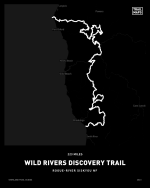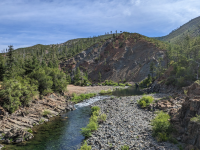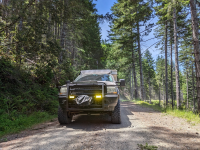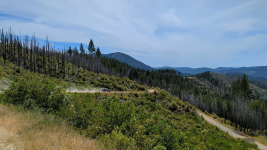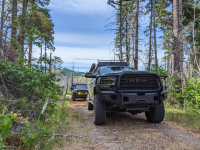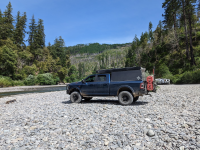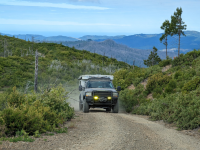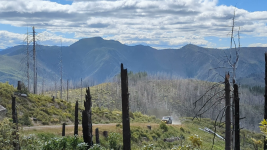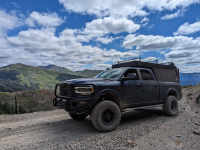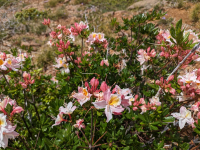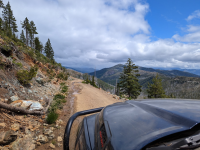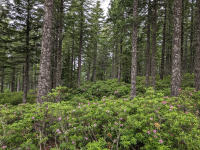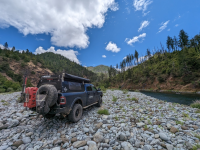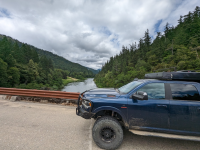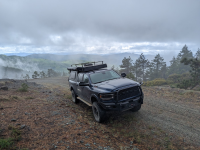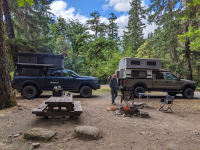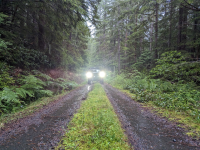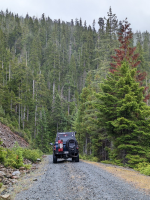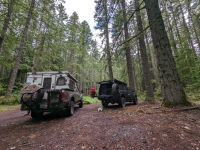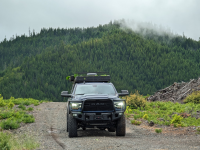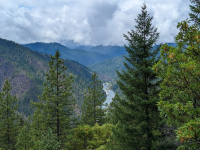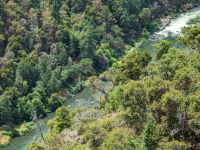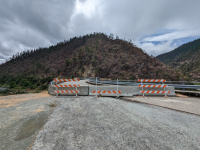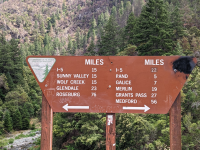OTG_1
Well-known member
My buddy Andreas and I had been planning our 10 day trip for the last several months. After hemming and hawing over visiting the North Rim of the Grand Canyon, I decided we'd change it up and head to the Klamath Mountains that straddled NW California and SW Oregon. The Klamaths have similar geology to the northern Sierra Nevada, and many geologists believe they're remnants of the same geological province, along with the Blue Mountains further to the northeast. Interestingly enough, all of these ranges are known for their gold deposits, although certainly none of the mining districts rival the most product mines found in the Sierra Nevada gold fields to the south.
I'd get a head start on Andreas, leaving my home from the North Bay (San Francisco Bay Area) and heading up to northern Mendocino County for a quick overnighter at Usal Beach. Usal can get a bit rowdy on weekenders over summer, so I was thankful I was visiting during the week. There were perhaps 10 or so vehicles camped in the vicinity, and the vibe was rather laidback (and quiet!). The weather was perfect as well. Somewhere in the 70s with a very slight breeze. I enjoyed a couple of cervezas, made a small fire, and reheated the carnitas that we'd made at home just a few days ago. An otter swam by in the creek, slyly hunting for its next meal. We ended up turning in around 9pm, as the pink horizon was beginning to turn black.
The next morning, the beach was enveloped in a thick fog. A family of ducks wandered the creek, the mother noisily quacking with her ducklings in tow behind her. I needed to be up in Arcata to meet Andreas by 9pm, so I hit the road early knowing it was over an hour to get back to highway 1. I dropped the tent and loaded Shasta the adventure shepsky into her familiar perch in the backseat. We pulled out of Usal and climbed up the steep switchbacks above the marine layer. It was pretty cool to look drive just above the fog line.
You can follow along on the Youtubez if you'd like as well!
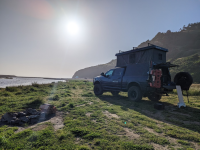
Another clear evening at Usal Beach.
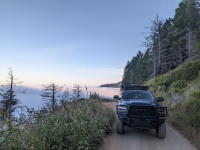
Driving above the fog along Usal Road.
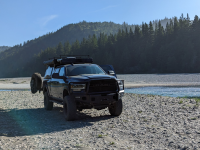
Dyerville Bar and the Eel River.
Well ahead of schedule and nary a cloud in sight, I made the quick drive down to Dyerville Bar, where two forks of the Eel River Converge. A few hours later we made it to the Arcata Plaza, but not without making a few stops along the way first. Hippies have long left the Bay Area, but Arcata is definitely still one of their strongholds. This funky college town prides itself for being weird and eccentric. And the bright, colorful buildings that surround the plaza only accentuate the funkiness. Shasta was getting a bit antsy waiting in the park. Her Husky half tends to come out in these situations, she's the type of dog that is most content on a long walk or run. And when sitting idly for a minute or two, she begins to vocalize her discontent with the situation. Luckily, Andreas arrived after a short 15 minute wait, that probably seemed like two hours to Shasta. We hit highway 101 headed north for the Smith River National Recreation Area. We'd be taking on some of my favorite portions of the Steelhead Adventure Trail.

Big Blue at the Arcata Plaza
There's so much to see an experience in northern Humboldt and Del Norte Counties. The drive along highway 101 is enough to make most folks smile, but we had bigger plans. We'd kick things off by jumping on the start of the Steelhead Adventure Trail at Howland Hill Road. Howland Hill is a 10 mile dirt road through the old growth forest of Jedediah Smith Redwoods. Jedediah Smith Redwoods features some of the largest known redwoods on earth, and the newly completed Grove of Titans trail takes visitors to some of the park's largest trees. We didn't get a chance to visit the grove on this trip, as the summer crowds were at in force, and it was friggin' hot for being so close to the coast.
After driving Howland Hill we followed the paved ribbon of highway along the Smith River to Gasquet Toll Road. This dirt road once connected the communities of southern Oregon (Cave Junction, Grants Pass, etc) to Crescent City, but now anyone can take the dirt road high into the Smith River NRA. As we gained elevation, we could see snow capped peaks all around us in the Siskiyous (a subrange of the Klamaths) and Klamath mountains. Gasquet Toll Road intersects with Wimer Road, and old wagon trail that the national forest leaves in its natural state-- which means lots of loose rocks. Wimer Road is by no means technical, but the neverending rocks will certainly keep you on your ties and wishing for smoother roads ahead. After bouncing along on Wimer Road for a couple of hours, we finally made it to our turn off to camp. The trail to camp winds its way several miles down a steep incline and through various tunnels of shrubs and trees. Even mid-sized vehicles like a 4Runner are guaranteed to pick up their fairshare of pinstriping-- imagine two full size trucks with campers on them!
It was a balmy 95F as we pulled into camp along the north fork of the Smith. I changed into my swim trunks as fast as I could, grabbed a cerveza (Scrimshaw to be exact), and made a beeline for the crystal clear waters of the Smith. Unlike the rivers and creeks in the Sierra, the Smith's waters are rather pleasant in the summer months as the majority of its water is not from snowmelt. I'd guess the water temp was somewhere around 70F. I splashed around in the water for an hour or so as one cerveza turned into three. Every being the loyal dog, Shasta followed me as I explored the river, and proudly perched myself atop a giant boulder. Day 1 our of our trip had gone well, and the cool river water was the perfect remedy for the blazing sun above us. We wondered what the coming days had in store for us as we'd head north into Oregon and the western corridor of the Rogue River-Siskiyou National Forest.
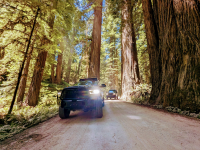
Howland Hill never disappoints.
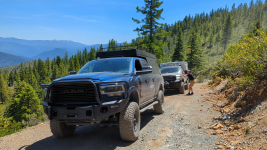
Smith River NRA
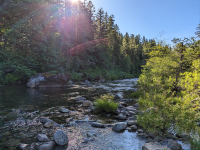
One of the many swimming holes along the north fork of the Smith.
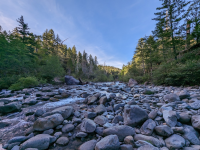
Further upstream from camp.
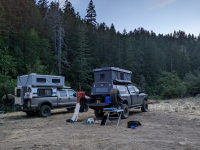
One of my favorite campsites in the PNW!
I'd get a head start on Andreas, leaving my home from the North Bay (San Francisco Bay Area) and heading up to northern Mendocino County for a quick overnighter at Usal Beach. Usal can get a bit rowdy on weekenders over summer, so I was thankful I was visiting during the week. There were perhaps 10 or so vehicles camped in the vicinity, and the vibe was rather laidback (and quiet!). The weather was perfect as well. Somewhere in the 70s with a very slight breeze. I enjoyed a couple of cervezas, made a small fire, and reheated the carnitas that we'd made at home just a few days ago. An otter swam by in the creek, slyly hunting for its next meal. We ended up turning in around 9pm, as the pink horizon was beginning to turn black.
The next morning, the beach was enveloped in a thick fog. A family of ducks wandered the creek, the mother noisily quacking with her ducklings in tow behind her. I needed to be up in Arcata to meet Andreas by 9pm, so I hit the road early knowing it was over an hour to get back to highway 1. I dropped the tent and loaded Shasta the adventure shepsky into her familiar perch in the backseat. We pulled out of Usal and climbed up the steep switchbacks above the marine layer. It was pretty cool to look drive just above the fog line.
You can follow along on the Youtubez if you'd like as well!

Another clear evening at Usal Beach.

Driving above the fog along Usal Road.

Dyerville Bar and the Eel River.
Well ahead of schedule and nary a cloud in sight, I made the quick drive down to Dyerville Bar, where two forks of the Eel River Converge. A few hours later we made it to the Arcata Plaza, but not without making a few stops along the way first. Hippies have long left the Bay Area, but Arcata is definitely still one of their strongholds. This funky college town prides itself for being weird and eccentric. And the bright, colorful buildings that surround the plaza only accentuate the funkiness. Shasta was getting a bit antsy waiting in the park. Her Husky half tends to come out in these situations, she's the type of dog that is most content on a long walk or run. And when sitting idly for a minute or two, she begins to vocalize her discontent with the situation. Luckily, Andreas arrived after a short 15 minute wait, that probably seemed like two hours to Shasta. We hit highway 101 headed north for the Smith River National Recreation Area. We'd be taking on some of my favorite portions of the Steelhead Adventure Trail.

Big Blue at the Arcata Plaza
There's so much to see an experience in northern Humboldt and Del Norte Counties. The drive along highway 101 is enough to make most folks smile, but we had bigger plans. We'd kick things off by jumping on the start of the Steelhead Adventure Trail at Howland Hill Road. Howland Hill is a 10 mile dirt road through the old growth forest of Jedediah Smith Redwoods. Jedediah Smith Redwoods features some of the largest known redwoods on earth, and the newly completed Grove of Titans trail takes visitors to some of the park's largest trees. We didn't get a chance to visit the grove on this trip, as the summer crowds were at in force, and it was friggin' hot for being so close to the coast.
After driving Howland Hill we followed the paved ribbon of highway along the Smith River to Gasquet Toll Road. This dirt road once connected the communities of southern Oregon (Cave Junction, Grants Pass, etc) to Crescent City, but now anyone can take the dirt road high into the Smith River NRA. As we gained elevation, we could see snow capped peaks all around us in the Siskiyous (a subrange of the Klamaths) and Klamath mountains. Gasquet Toll Road intersects with Wimer Road, and old wagon trail that the national forest leaves in its natural state-- which means lots of loose rocks. Wimer Road is by no means technical, but the neverending rocks will certainly keep you on your ties and wishing for smoother roads ahead. After bouncing along on Wimer Road for a couple of hours, we finally made it to our turn off to camp. The trail to camp winds its way several miles down a steep incline and through various tunnels of shrubs and trees. Even mid-sized vehicles like a 4Runner are guaranteed to pick up their fairshare of pinstriping-- imagine two full size trucks with campers on them!
It was a balmy 95F as we pulled into camp along the north fork of the Smith. I changed into my swim trunks as fast as I could, grabbed a cerveza (Scrimshaw to be exact), and made a beeline for the crystal clear waters of the Smith. Unlike the rivers and creeks in the Sierra, the Smith's waters are rather pleasant in the summer months as the majority of its water is not from snowmelt. I'd guess the water temp was somewhere around 70F. I splashed around in the water for an hour or so as one cerveza turned into three. Every being the loyal dog, Shasta followed me as I explored the river, and proudly perched myself atop a giant boulder. Day 1 our of our trip had gone well, and the cool river water was the perfect remedy for the blazing sun above us. We wondered what the coming days had in store for us as we'd head north into Oregon and the western corridor of the Rogue River-Siskiyou National Forest.

Howland Hill never disappoints.

Smith River NRA

One of the many swimming holes along the north fork of the Smith.

Further upstream from camp.

One of my favorite campsites in the PNW!
Last edited:

